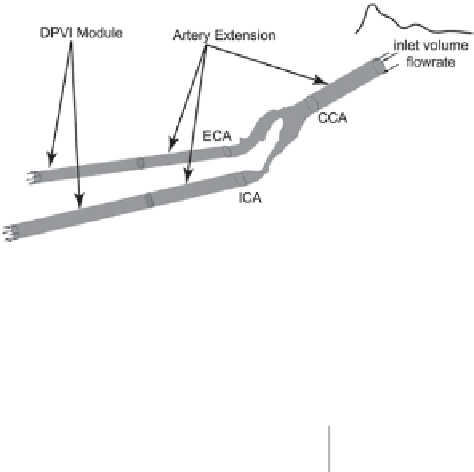Biomedical Engineering Reference
In-Depth Information
Fig. 7.16
Domains configuration for the computational haemodynamics of carotid bifurcation
model. In order to eliminate the local fluid dynamic effects on the reconstructed fluid domain,
flow extensions were attached to the carotid bifurcation model; two DPVI modules with differ-
ence transient porosities were connected downstream of the artery model to represent downstream
flow resistance
Table 7.2
Geometrical parameters of the introduced porous mediums
Patients
Diameter
(mm)
Cross-sectional
area (mm2)
Length (mm)
Healthy Carotid
Bifurcation
ECA Porous Medium
4
12.6
40
ICA porous Medium
4
12.6
40
Atherosclerotic
Carotid Bifurcation
ECA Porous Medium
4.6
16.6
46
ICA porous Medium
5.6
24.6
56
Based on Equation (7.7) the permeability variation of the porous medium
(kA/
η
Lp) reflects the downstream vascular impedance
R
= −Δ
P
/
Q
. Therefore,
the downstream ICA and ECA porous domain permeability can be used for other
carotid bifurcation models to approximate the vascular bed impedance, and a stan-
dard peripheral flow environment can be established for the carotid bifurcation hae-
modynamics.
The porous domain is then connected to the carotid bifurcation. The 3D unsteady
incompressible Navier-Stokes equations were solved by a second order implicit
backward Euler method, and the SIMPLE pressure-velocity coupling was used. The
Wilcox low-
Re k
-
ω
turbulence model (Wilcox 1998) was chosen for all the simula-
tions to predict low-
Re
effects on the turbulence field at the near-wall regions.
Vessel walls were assumed rigid for all models (Hoi et al. 2010), and the con-
vergence criterion for the relative residual of all dependent variables was set to
1 × 10
−4
. Two full cardiac cycles were required to damp the initial transient errors.
The third cycle was used for data analysis (Ghalichi and Deng 2003). Studies of
grid independence based on scales of 0.8, 0.6, 0.4, and 0.2 mm and time-step size
dependence based on time-steps of 0.01, 0.008, 0.005, and 0.002 s were performed
based on the healthy carotid bifurcation model using the prescribed inlet and outlets
boundary conditions. The investigation results are shown in Table
7.3
. Accounting
for the computational expenses, the most efficient grid scale
L
G
and time-step size
t
settings are
L
G
= 0.4 mm,
t
= 0.005 s.




































Search WWH ::

Custom Search